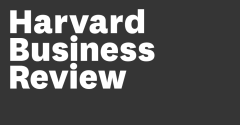How much are you using ChatGPT or Claude or one of the other LLMs in your job? Have you, like the Amys, largely avoided it because you haven’t been impressed with what you’ve seen it do? Or you haven’t thought of a compelling use case? Or maybe you feel professionally threatened?
The Amys have gone from being skeptical dabblers to skeptical enthusiasts. Why? They heard several listeners describe how they’ve gotten surprisingly good results, not to mention mental relief, greater agency at work, and imaginative business leads.
If you haven’t yet tried your hand at GenAI, we hope these power users, along with our guest expert, data journalist Alexandra Samuel, inspire you to finally do that; and if you’re already using the technology, that you come away with new ideas.
Guest expert:
Alexandra Samuel is a tech speaker and data journalist who creates data-driven reports and workshops for companies around the world.
Resources:
- “How the Next Generation of Managers Is Using Gen AI,” by Gabriele Rosani and Elisa Farri
- “Using ChatGPT to Make Better Decisions,” by Thomas Ramge and Viktor Mayer-Schönberger
- “The AI Skills You Should Be Building Now,” from the HBR IdeaCast
- “A Toolkit to Help You Manage Uncertainty Around AI,” by Oguz A. Acar and Bob Bastian
- “Embracing Gen AI at Work,” by H. James Wilson and Paul R. Daugherty
Sign up for the Women at Work newsletter.
Email us: womenatwork@hbr.org
AMY GALLO: You’re listening to Women at Work from Harvard Business Review. I’m Amy Gallo.
AMY BERNSTEIN: And I’m Amy Bernstein. Some of us have gone all in on generative AI.
AMY GALLO: Like these audience members of ours.
BARBARA RUIZ: So, I created this custom GPT for my job. It was a game changer for me. Before, if I had a problem, it would take me one day to solve. Right now, with these tools, I will do it, I don’t know, in three hours.
ERIN MORAN: It drastically increases efficiency and proficiency. I am able to be a better leader, produce more work. I have definitely come to rely on it.
ANDREA PLEBANI: I’m just so much more satisfied in my work because the opportunity to step back and look at things and translating it into something that’s actionable for my teams, that’s a huge value add.
PAM BOIROS: Computers now speak our language, so we can use our own English language skills to tease what we want out of these tools.
JULIE PRICE: So, you hire a fake team of researchers, and each one of your fake researchers comes up with a research plan. And then what’s better is if you create a character who’s a behavioral economist on the team, and a behavioral economist will come in and look at all the results of this research and tell you what’s unrealistic. It’s just unbelievably different and more impactful, the stuff you can do.
AMY GALLO: Ame, have you had these revelations about AI yet? [Laughter]
AMY BERNSTEIN: Not even close. I mean, I’ve asked it to do things that I was pretty sure it would fail at, and it did not disappoint me, so that just affirmed for me that I didn’t really need to pay that much attention.
AMY GALLO: Wait, what do you mean you asked the things you knew?
AMY BERNSTEIN: Oh, maybe three months after ChatGPT debuted, I was writing a condolence letter. And I don’t know about you, but I find those really hard.
AMY GALLO: Hard to get started.
AMY BERNSTEIN: Hard to get—actually just hard to do, hard to do the middle part and hard to end. But I thought, well, okay, do it, write me my condolence letter. And I came up with several prompts, and I was tweaking the prompts, and you know, it never came up with something that I could put down on a card and send.
AMY GALLO: Yeah.
AMY BERNSTEIN: I’m kind of relieved at that though—
AMY GALLO: Yes.
AMY BERNSTEIN: —to be honest.
AMY GALLO: That relief I think is exactly where I am with this, which is that I recognize it’s powerful. I know it could be transformational for me, certainly for my work, definitely for the world, and yet I don’t want to accept it. And so when it fails, I’m so happy. I still have a job! Yay!
AMY BERNSTEIN: You see? You see?
[Laughter]
AMY BERNSTEIN: Well, except, these are early days, and this technology is going to learn so quickly.
AMY GALLO: I agree. I know it’s going to change the way I relate to my work.
AMY BERNSTEIN: How so? Say more about that.
AMY GALLO: Well, there are just aspects of my work that I don’t like that this could help with. And we’ll get into it in a little bit, the power users we’ve heard from, because this is who I’m really basing this on, is the women who wrote in to us, to told us how they’re using it. And whether we like it or not, whether we want it to fail or not, it’s happening; and so we have to be early adopters. Although we’re late on that. We have to be middle adopters—
AMY BERNSTEIN: Yeah, we missed that boat.
AMY GALLO: [Laughter] Yeah. We have to adopt, let’s just put it that way. We have to adopt.
In listening to women like us, like you, describe how GenAI has saved them time, broadened their thinking, deepened their agency at work. Amy B and I have gone from being skeptical dabblers to being skeptical enthusiasts. Maybe listening will have the same effect on you.
AMY BERNSTEIN:nIf you haven’t yet tried your hand at GenAI, we hope these power users inspire you to finally give it a try; and if you’re already using the technology, that you come away with some new ideas.
AMY GALLO: One of the things I was really struck by was the mental and emotional relief that GenAI gave them.
AMY BERNSTEIN: Blew me away.
AMY GALLO: Yeah, because of course I expect the opposite because that’s been my experience. It makes me anxious. I don’t know how to use it. It’s going to take my job. Ah! And for them to actually be able to begin to use it in their day-to-day work, and almost all of them use it on a daily basis, but to relieve mental burdens such as burnout or task paralysis, it’s just been a huge source of relief.
AMY BERNSTEIN: Can we hear from someone?
AMY GALLO: Yeah, let’s listen to what Andrea has to say.
AMY BERNSTEIN: Yeah.
ANDREA PLEBANI: I would consider myself a middle manager. So, at the time I discovered ChatGPT and generative AI in general, I, like many people, was coming off several very difficult years: difficult personally, difficult from a work perspective, and also very difficult as a leader.
Going through the pandemic, we really wanted to be authentic and present for what was going on in people’s lives as individuals. And that’s a lot. It was draining. And I definitely had reached the stage of burnout, and that’s where the generative AI really made a huge difference in that was, how much energy do I put into things? Because there’s so much in your day that just comes through that you have to react to, react to, react to, and you definitely need to put some thought into it, but you’re not writing the U.S. Constitution.
And so rule of thumb, if I’m likely to overthink it, let me think of a prompt. Let me think of a way to respond to this that doesn’t require as much mental effort or kind of right-sizes the level of mental effort to the task at hand. Because the things that, like I said, shouldn’t require so much of our energy often do.
The power of being able to just jot down a few thoughts, make an executive summary of this…boop, here’s three bullet points. Rewrite this for a group of cross-functional stakeholders. Boop, there it is. Make this sound more professional. Make it sound more casual. Make it longer. Make it shorter. Expand on this point. Emphasize this. Define a call to action. Boop. It feels like a miracle.
AMY BERNSTEIN: So, when I think of the many, many moments of misery of I’ve experienced in my career, I cannot tell you how high a proportion of them had to do with not being able to right-size the effort and attendant anxiety to the task at hand.
AMY GALLO: Yes. Well, and to not get stuck in that moment of, how important is this thing? And if I know it’s not that important, why am I spending so much time thinking about it?
AMY BERNSTEIN: Right.
AMY GALLO: And what Andrea is describing is almost a way to short circuit your perfectionism.
AMY BERNSTEIN: Oh, absolutely. I’d love to hear from another listener who uses it in a similar way, but in a different context to focus herself in a way that is more appropriate and will get her to her goal.
JESSICA MCBRIDE: I’m Jessica McBride, the founder of Tech Savvy Assistant. I created Tech Savvy Assistant after being laid off from my EA tech job based out of New York. I used ChatGPT because it was the original one. And I realized quickly how functional and helpful it was for admin roles, especially because there’s too many nuances that go into what we’re trying to solve that cannot really be encapsulated by a Google search. And so by using ChatGPT, I was able to take these, like I said, really nuanced problems and parcel them down into something that was a much more accessible way for me to take a problem on.
A problem that we come across a lot of times in the admin field is somebody comes to us and they’re like, “Hey, I’d like for you to do an event,” and they give us this vague idea—synergy—and I would just be like a deer in the headlights. But you can workshop this idea of like, “Okay, we need to do a three-day conference based around the idea of synergy. Help me come up with a step-by-step guide on how to produce this event.” And what I love about it is that, yes, I’m perfectly capable of creating this event on my own, but what am I going to miss? What steps am I not noticing? What else would I like to take into consideration for this? And it’s going to give such a well-rounded idea of what you want to create. It’s just giving you the roadmap.
A lot of people in my industry latched on to this idea of, AI isn’t going to replace you; an EA using AI will, and I don’t like that. I think that that is anti-fellow worker. I think it’s no different than, you know, getting introduced to the internet. This is the next level of like, I just need to learn how to embrace and use it and utilize it to the best of my ability. And I can really empower my career and become the next generation of executive assistant.
There are so many things that we can do to, like, increase the culture and be strategic business partners and think and expand that I did by just talking to, you know, other leaders in our organization and solving problems. But like, you can use AI to help you solve these problems.
AMY BERNSTEIN: What I heard in that that really excited me was this idea of breaking down the daunting challenge into completable tasks. Right? I found myself wondering if LLMs are freeing admins to do higher level work, how are they doing that? And Jessica has really tackled that.
AMY GALLO: Yeah.
AMY BERNSTEIN: It’s incredibly impressive. She has figured out how to use the technology to do a better job of identifying her executives’ objectives.
AMY GALLO: And she’s actually codifying—
AMY BERNSTEIN: Codifying and making it available.
AMY GALLO: —all of this and making it available to other EAs, which is just so smart.
AMY BERNSTEIN: I have the guide in my hand, Ame, and let me just read you some of the others. Identifying resources and obstacles. I cannot tell you how many hour-long meetings I’ve sat through, participated in, where we were trying to identify resources and obstacles, and she has a bot that does that.
AMY GALLO: Yeah.
AMY BERNSTEIN: Developing an action plan. When I read this, I thought, well, this is everyone who has anything to do with formulating strategy and executing on strategy.
AMY GALLO: And she’s, again, making that available to anyone. That’s one of the things that I think is really encouraging about these power users is so many of them are not just creating these tools for themselves, but also thinking about how it can benefit their clients, their friends, their community, their network.
JESSICA MCBRIDE: You can visit techsavvyassistant.com, and on there you’ll find things like my newsletter that goes out weekly, that often includes videos and clips of how I’m utilizing ChatGPT. I also have a community that you can join. So, it’s really focused on keeping you current in what is happening in technology.
AMY GALLO: The other thing that I heard in Jessica and Andrea’s stories were that they are using it to get unstuck.
AMY BERNSTEIN: Yeah.
AMY GALLO: I want to go back to that for a second because as you said earlier, the amount of agony we’ve spent in these indecisive moments, and it’s something I actually really worry about with myself, is that I tend to be indecisive about certain types of decisions. And I’ve actually worked with a coach to help me on certain decisions. So, when an opportunity comes to me, whether I say yes or no is so overwhelming to me, and I’ve actually worked with the coach to come up with the criteria: When will I say yes? When will I say no? And I go through that criteria, I rank it. But as I’m listening to Jessica talk, I’m thinking, why don’t I make that a bot?
AMY BERNSTEIN: Why don’t you make that a bot?
AMY GALLO: And just, I already have the criteria. I can feed it decisions I made before, so it knows what I’ve said yes to. I can also feed it all of the sample language I’ve developed around saying no, because that’s often the hurdle is that I decide I’m going to say no, but now I have to write the no. And that’s really uncomfortable for me. So, I can feed it that sample language and I can say, “Should I say yes or no to this decision?” Why? Using my criteria, tell me why. Can you please write a note saying no, if the answer is no.” It often is.
AMY BERNSTEIN: Yeah. And it really brings home to me how we’re really only limited by our own imaginations how we could use this technology. And you described the steps. It’s not that complicated.
AMY GALLO: It’s not. But if someone said, “Oh, you should develop a bot that will help you make decisions,” two weeks ago, I would’ve said, “Yeah, that sounds great… Never.”
AMY BERNSTEIN: Yeah.
AMY GALLO: “I don’t have the time for that. Will the amount of time I’m going to put in actually benefit me? Like, eh, no.” But listening to these women describe how they’re using it makes it seem so much more doable.
AMY BERNSTEIN: Yeah. And it helps externalize that anxiety. If you do it right, you’re going to get to the same conclusion, but you want to put yourself through all the stress of getting there.
AMY GALLO: Right. We have some other users who have been using it as sort of thought partners, and I’d like to hear from them in terms of how are they using it to both get unstuck, but also helping them generate ideas and think creatively. Because I think that’s one of the things we’ve often thought it wouldn’t be able to do is creativity. But let’s hear from Pam first.
PAM BOIROS: So, for example, I am working on an account-based marketing program for a client, and I’m a marketing leader, so I’ve done a lot of account-based marketing programs in my day, but it’s really easy to sort of get stuck in a rut.
So, I actually put a prompt and said, “I am working on an account-based marketing program for this company. We want to save these types of messages. What are some tactics that I should think about? What are some approaches that I should think about?”
And it actually came back with a list of the personas that I might be contacting. And the kind of company that I’m working for is in the HR space. So, I’m used to speaking to chief human resources officers and heads of recruiting and heads of talent. But one of the suggestions that it came back with was heads of operations. And I said, “Oh, that’s really interesting. I’ve not really worked with that persona before.”
So, I kind of furthered that query and said, “Okay, tell me about heads of operations. Tell me about that persona.” So, the suggestion that it came back with is, heads of operations are really thinking about costs and cost savings and to consider building a calculator based on some very specific criteria and metrics related to operational costs. It would’ve never occurred to me to do that. So, whether we actually do that…and I could have, and I probably will at a separate time, continue that conversation with the AI to tease out other ideas for reaching out to that buyer persona.
AMY GALLO: What I like about that use case is that—because one of the hesitations and one of, I will now say an excuse that I’ve been using about not using GenAI as much is that it’s not accurate—that’s a great case where it doesn’t need to be accurate. It’s just suggesting something she might explore and in partnership with her continuing to explore it.
AMY BERNSTEIN: Right.
AMY GALLO: She even says, whether we actually do that or not, that’s yet to be seen. But it’s a new idea for me to think about.
AMY BERNSTEIN: Right. That’s creative.
AMY GALLO: Yeah. And to think about the sources of input I get on a project I’m working on, right? Who am I not reaching out to get that input? Or I have a target audience when I’m writing an article. Who am I not considering part of that target audience that might be it? I mean, it used to be we had to spend tens of thousands of dollars, maybe more and months to get that data about potential readers. But now we can begin to imagine who else might we include? And that’s going to change the way we think about ideas, the way we market the products we create.
AMY BERNSTEIN: The thoroughness of the consideration. Because you always worry about what you’re missing.
AMY GALLO: Yes.
AMY BERNSTEIN: Everything we’re talking about here, while we’re a little bit starry eyed. It’s also making me uncomfortable. I don’t know.
AMY GALLO: Sure.
AMY BERNSTEIN: Yeah. Because if these agents can do such a good job, then what do we need us for?
AMY GALLO: And that is a huge question.
AMY BERNSTEIN: It is. And unanswered.
AMY GALLO: Unanswered.
AMY BERNSTEIN: So, I’m going to say a year and a half ago I was recording a conversation with Karim Lakhani, who is one of the experts on AI and particularly generative AI, he’s over at Harvard Business School. And he was saying to me that it would take almost nothing for him to create an Amy bot. I edit him. He’s got a lot of correspondence for me. He’s got all of the marked-up drafts, and he said, “Yeah, it really wouldn’t be hard at all.” Just recounting this to you is giving me the chilly horrors, right?
AMY GALLO: Yeah, yeah.
AMY BERNSTEIN: Because I know he could do it.
AMY GALLO: Right. Well, but why didn’t he, I wonder?
AMY BERNSTEIN: Why didn’t he?
AMY GALLO: Is it out of respect, or is there something he knows—
AMY BERNSTEIN: Oh, he’s got way more important things to do I think.
AMY GALLO: Well, maybe that’s it. Maybe that’s it. He is like, I’ll let Amy keep her job cause I’m too busy.
AMY BERNSTEIN: Thanks, Karim.
AMY GALLO: All right. Well, let’s talk about another way that these women are using AI and in particular around professional development and career empowerment.
BARBARA RUIZ: So I am Barbara Ruiz, I’m an SAP consultant, and I started using AI because my dad taught me. It was a game changer for me because in my role as SAP consultant, there is a lot of deep analysis, complex problem solving. So, I created this custom GPT for my job. I put how I wanted the GPT to present me the information, and then also where I wanted the information to be retrieved from. And also some PDF that I had with knowledge I have been gathering through the years.
I now solve technical issues that before they were outside of my expertise. Because the GPT will guide me step by step. And even if it won’t give you the solution, it can give you very good hints at how you can get to the solution.
It’s faster. It requires less people also because then I don’t have to call all the time the developers. And I feel honestly, it’s very empowering because now I don’t need other people to help me. And just like I can do it by my own, I’m very happy to be able to improve my efficiency and to have also a bit of free time because that also have helped me to have free time.
AMY GALLO: The thing Barbara said about working more independently and not having to call the developers, I found that really both exciting and terrifying.
AMY BERNSTEIN: What happens when we don’t need other people any more Amy?
AMY GALLO: Yeah. And this is one of the things I always worry about new technologies that promise efficiency is that sometimes the most efficient way isn’t the best way. And there’s a certain amount of friction that we need to generate new ideas to form relationships, to build trust, to resolve conflicts, that I worry we’re trying to smooth the edges of the messiness of work in a way that’s going to end up dampening our humanness.
But I think that’s a good segue actually to hearing from Julie because she used to work for a company doing user research and customer development, but she recently went independent and actually has a startup that creates personalized meditations for children. Such a great idea for company.
AMY BERNSTEIN: Oh my gosh. Yeah.
AMY GALLO: And needed to create an interactive website to do that. And she wasn’t sure how to do it. She wasn’t a web developer. She didn’t have these skills. And what she did, to our point about who do you turn to, do you need actual help? She created a fake team, a multi-agent team—
AMY BERNSTEIN: Oh my gosh.
AMY GALLO: —that could help her do it, and it worked. Let’s hear. We can talk about what this makes us feel, but let’s hear her describe it.
JULIE PRICE: So, I went over to Claude and I said, “You are managing my development team. On my team, I have a software engineer, I have a code executor, I have a designer, and I have a planner. I’m going to tell you what I want, and I want you to manage these four people for me and solve my problem.”
And it was bonkers. Over the course of the next few weeks, I completely… from somebody who doesn’t know how to code…it’s not just not even knowing how to code, it’s not even knowing how do you use GitHub? How do you push to a server? What’s my tech stack? How am I doing any of this? It wrote me every single piece of code that I needed, told me where to put it, told me how to execute it, help me get set up with GitHub. I got Google Analytics.
I mean, this was a website I wanted to look a certain way. I can’t just copy and paste every single thing. So, it would create some code for me. And then I would ask it questions like, “Why did you do this? Explain this to me. How am I using this technology? Why are things working in this way?”
And so I will never be a software engineer, but I am a lot closer than I ever was. And now I can actually have conversations that I couldn’t have before. And I was honest with it, which more honest than I would be with a real person, I would say, “Look, I don’t understand this, explain it to me like a person who doesn’t understand this.” But it was bonkers. I mean, it worked. I did something I could never do.
AMY BERNSTEIN: Well, and that sound you just heard was another industry going down. Right?
AMY GALLO: The death knell. The death knell. But to our point earlier, I do think there’s something missing. I don’t know if it’s a lack of expertise, but that sort of creative energy. But then I hear in Julie’s voice, it sounds like she got it. I don’t hear anything sort of lamenting the loss of human interaction.
AMY BERNSTEIN: Well, it definitely addressed her need and did it in an efficient way, in a way she couldn’t have done on her own. To me, it highlights the importance of the smart dumb question. You know, the generalist intelligence, because we’re blinded often by our expertise.
AMY GALLO: Yeah, yeah.
AMY BERNSTEIN: And in this case, a lot of what she brought to the party was knitting together all of that work by asking the non-expert questions.
AMY GALLO: Yes. Yeah. My eighth-grade teacher, eighth-grade math teacher, had this big sign in her classroom that said, the only dumb question is the one you don’t ask.
AMY BERNSTEIN: Yes.
AMY GALLO: And I think about that a lot in the work that I do because oftentimes people don’t ask the question because they’re afraid of looking stupid. And Julie refers to that. She was asking it questions that she probably wouldn’t





